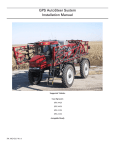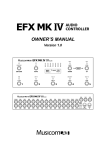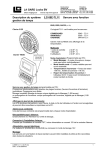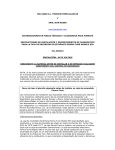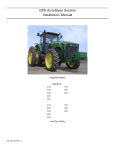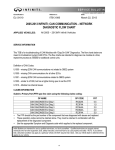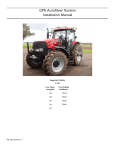Download GPS AutoSteer System Installation Manual
Transcript
GPS AutoSteer System Installation Manual Supported Vehicles CNH Case Accuguide New Holland Intellisteer MX-210 MX-230 TG-210 TG-215 MX-255 MX-285 TG-230 TG-245 MX-215 MX-245 TG-255 TG-275 MX-275 MX-305 TG-285 TG-305 T8010 T8020 T8030 T8040 MX-335 T8050 PN: 602-0224-01-A LEGAL DISCLAIMER Note: Read and follow ALL instructions in this manual carefully before installing or operating the AutoSteer system. Note: Take careful note of the safety information in the Safety Information section and throughout this manual. The manufacturer disclaims any liability for damage or injury that results from failure to follow the instructions and warnings set forth herein. Please take special note of the following warnings: 1. There is NO obstacle avoidance system included in the manufacturer’s product. Therefore, users must always have an operator on the equipment when the AutoSteer system is in use to look for any obstacles including people, animals, trees, ditches, buildings, etc. 2. During installation of the AutoSteer system and during the Calibration and Tuning processes the vehicle's wheels turn from side to side and the vehicle moves. Be sure that all people and obstacles are clear of the vehicle before installation, calibration and tuning, or use of the AutoSteer system. 3. Use of the AutoSteer system is NOT permitted while the vehicle is on public roads or in public areas. Ensure that the system is OFF before driving on roads or in public areas. ii AutoSteer System Special Requirements Tools This list consists of the tools required to complete the installation. The installer is assumed to have a complete set of common installation tools. Allen Hex Key 1/4” 11/16” open wrench 16mm open wrench Allen Hex Key 3/16” 5/8” open wrench 17mm open wrench Allen Key 5/32” 9/16” open wrench (2x) 18mm open wrench Allen Hex Key 1/8” 1/2” open wrench 19mm open wrench 15/16” open wrench 7/16” open wrench 22mm open wrench 7/8” open wrench 15/16” socket wrench 24mm open wrench 13/16” open wrench 13mm open wrench #1 Phillips screwdriver 3/4” open wrench Wire cutter small #2 Phillips screwdriver Cleaning brush Tape measure (12ft minimum) Cleaning rags 10 Foot Ladder Fiberglass Cable Puller Hardware Installation Guide iii Safety Information Warning Alerts The AutoSteer system installer and manufacturer disclaim any responsibility for damage or physical harm caused by failure to adhere to the following safety requirements: • • As the operator of the vehicle, you are responsible for its safe operation. The AutoSteer system is not designed to replace the vehicle’s operator. Note: Verify all screws, bolts, nuts, and cable connections are tight after the final installation of the AutoSteer system on the vehicle. WARNING To avoid electrical shock hazards, remove the Roof Module from the vehicle before driving under low structures or low electrical power lines. WARNING To prevent injury from falling, ensure you are in a stable position on the vehicle when installing or removing the Roof Rail and Roof Module. If the vehicle does not provide a safe platform, use a ladder to safely access the vehicle roof while installing or removing the Roof Rail and Roof Module. WARNING To prevent accidental death or injury from being run over by the vehicle, never leave the vehicle's operator chair with the AutoSteer system engaged. iv AutoSteer System WARNING To understand the potential hazards associated with the operation of AutoSteer system equipment read the provided documentation before installing the AutoSteer system on a vehicle. WARNING To prevent the accidental engagement of AutoSteer and loss of vehicle control while driving on roads, shut down the AutoSteer system (exit the program). Never drive on roads or in public areas with the AutoSteer system turned on. Hardware Installation Guide v Caution Alerts The AutoSteer system installer and manufacturer disclaim any responsibility for damage or physical harm caused by failure to adhere to the following safety requirements: CAUTION The Roof Module must be removed when transporting or driving the vehicle at speeds above 30 mph (50 km/h). The Roof Module can possibly detach due to wind loads at higher speeds. CAUTION The AutoSteer system does not detect obstacles in the vehicle’s path. The operator must observe the path being driven in order to avoid obstacles. CAUTION When engaged, the AutoSteer system controls only the steering of the vehicle. The operator must control the speed of the vehicle. CAUTION The AutoSteer system must be powered OFF when installing or removing the Roof Module. vi AutoSteer System CAUTION The AutoSteer system must be powered OFF when starting or cranking the vehicle’s engine. CAUTION The Roof Module must always be firmly secured to the Roof Rail using the hardware whenever the vehicle is in operation to prevent the Roof Module from releasing from its bracket and falling. Vehicle Requirements The vehicle steering system must be in good working order before installing the AutoSteer system. Check for loose or worn parts. Before installing the AutoSteer system drive the vehicle and confirm that it steers straight and the wheels can be turned from lock to lock. Check the steering system connections to ensure there are no oil leaks. The vehicle electrical system and battery must be in good working order. The vehicle should be fully cleaned before installing the AutoSteer system. A clean vehicle will improve the overall installation and cable routing. This installation kit is designed for tractors that are 'steer ready' from the factory so the tractor must be equipped with an AutoSteer valve on the Steering Orbitrol and a kingpin angle sensor. Hardware Installation Guide vii Important Information Note: Verify all screws, bolts, nuts, and cable connections are tight after the final installation of the AutoSteer system on the vehicle. Technical Support Refer to your Display user manual for technical support information. Contact Information Refer to your Display user manual for contact information. Copyright © 2009 All Rights Reserved. viii AutoSteer System Table of Contents Chapter 1 Installation Overview....................................................................................... 1 Vehicle Inspection . . . . . . . . . . . . . . . . . . . . . . . . . . . . . . . . . . . . . . . . . . . . . . . . . . . . . . . . . . . 1 Kit Components . . . . . . . . . . . . . . . . . . . . . . . . . . . . . . . . . . . . . . . . . . . . . . . . . . . . . . . . . . . . . 2 Installation Procedure Outline . . . . . . . . . . . . . . . . . . . . . . . . . . . . . . . . . . . . . . . . . . . . . . . . . . 3 Cable Diagram . . . . . . . . . . . . . . . . . . . . . . . . . . . . . . . . . . . . . . . . . . . . . . . . . . . . . . . . . . . . . . 4 Chapter 2 SA Module Installation..................................................................................... 5 SA Module Mounting Orientation . . . . . . . . . . . . . . . . . . . . . . . . . . . . . . . . . . . . . . . . . . . . . . 6 Mount the SA Module Bracket . . . . . . . . . . . . . . . . . . . . . . . . . . . . . . . . . . . . . . . . . . . . . . . . . 6 Mounting the SA Module on Older Vehicles . . . . . . . . . . . . . . . . . . . . . . . . . . . . . . . . . . . . 7 Mounting the SA Module on Newer Vehicles . . . . . . . . . . . . . . . . . . . . . . . . . . . . . . . . . . . 8 Chapter 3 Roof Module Installation ................................................................................ 11 Safety Notes . . . . . . . . . . . . . . . . . . . . . . . . . . . . . . . . . . . . . . . . . . . . . . . . . . . . . . . . . . . . . . . 11 Roof Rail Installation . . . . . . . . . . . . . . . . . . . . . . . . . . . . . . . . . . . . . . . . . . . . . . . . . . . . . . . . 12 Chapter 4 Display Installation ........................................................................................ 17 Introduction . . . . . . . . . . . . . . . . . . . . . . . . . . . . . . . . . . . . . . . . . . . . . . . . . . . . . . . . . . . . . . . 17 Installation Procedure . . . . . . . . . . . . . . . . . . . . . . . . . . . . . . . . . . . . . . . . . . . . . . . . . . . . . . . 17 Chapter 5 Connecting System Cables............................................................................. 19 SA Module Harness . . . . . . . . . . . . . . . . . . . . . . . . . . . . . . . . . . . . . . . . . . . . . . . . . . . . . . . . . 19 SA Module Connection . . . . . . . . . . . . . . . . . . . . . . . . . . . . . . . . . . . . . . . . . . . . . . . . . . . . 20 Wheel Angle Sensor Connection. . . . . . . . . . . . . . . . . . . . . . . . . . . . . . . . . . . . . . . . . . . . . 22 Steering Valve Connections . . . . . . . . . . . . . . . . . . . . . . . . . . . . . . . . . . . . . . . . . . . . . . . . 26 Main Cable Harness . . . . . . . . . . . . . . . . . . . . . . . . . . . . . . . . . . . . . . . . . . . . . . . . . . . . . . . . . 35 Roof Module . . . . . . . . . . . . . . . . . . . . . . . . . . . . . . . . . . . . . . . . . . . . . . . . . . . . . . . . . . . . 36 Main Cable Harness Connections Inside Cab . . . . . . . . . . . . . . . . . . . . . . . . . . . . . . . . . . . 39 SA Module Harness . . . . . . . . . . . . . . . . . . . . . . . . . . . . . . . . . . . . . . . . . . . . . . . . . . . . . . . 40 Power Supply Connection . . . . . . . . . . . . . . . . . . . . . . . . . . . . . . . . . . . . . . . . . . . . . . . . . . . . 40 Cab Power Connection . . . . . . . . . . . . . . . . . . . . . . . . . . . . . . . . . . . . . . . . . . . . . . . . . . . . 41 Battery Power Connection . . . . . . . . . . . . . . . . . . . . . . . . . . . . . . . . . . . . . . . . . . . . . . . . . . 41 Chapter 6 Post-Installation Procedures and Information .................................................... 43 Create New Vehicle . . . . . . . . . . . . . . . . . . . . . . . . . . . . . . . . . . . . . . . . . . . . . . . . . . . . . . . . . 43 Calibration and Tuning Guidelines . . . . . . . . . . . . . . . . . . . . . . . . . . . . . . . . . . . . . . . . . . . . . 43 Transducer Calibration . . . . . . . . . . . . . . . . . . . . . . . . . . . . . . . . . . . . . . . . . . . . . . . . . . . . 43 Chapter 7 Final Hardware Installation Checklist ............................................................... 45 Hardware Installation Guide ix x AutoSteer System 1 Installation Overview This Installation Overview chapter contains part numbers, kit overview diagram, cabling diagram and the installation procedure. • • • • Vehicle Inspection Kit Components Installation Procedure Outline Cable Diagram This installation guide describes the installation of the AutoSteer system on several models of Case MX Accuguide ready and New Holland TG IntelliSteer ready tractors. The installation kit PN: 188-0034-01 is used on both series of these wheeled tractors. Vehicle Inspection Before you install the AutoSteer system, confirm the vehicle steering system is in good working order. Drive the vehicle and verify the vehicle’s correct working order. Also, ensure the following system operations and components: • • • • • Check to see if you can turn the steered wheels from lock to lock. Ensure the vehicle steers straight. Check for loose or worn steering components. Service the vehicle if the steering is not in good working order. Confirm the tractor has the Accuguide valve and other components already installed. Hardware Installation Guide 1 Kit Components Figure 1-1 Kit Components (PN: 188-0034-01) Table 1-1 Installation Kit Components (PN: 188-0034-01) Item Component Part Number 1. RAM Mount Double U-bolt 207-0010-01 2. Mounting Hardware 200-0076-01 3. Roof Module Adapter Brackets 200-0387-01 4. Installation Guide 602-0224-01 5. SA Module Assembly 200-0206-01 6. SA Module Harness 201-0351-01 7. Display Bracket Assembly 200-0190-01 8. Common Installation Kit 200-0497-02 9. Type A Harness Adapter 201-0405-02 2 AutoSteer System Item Component Part Number 10. Type B Harness Adapter 201-0407-02 11. Warning Labels 603-0074-01 Installation Procedure Outline Note: The system interconnect cable diagram in the Cable Diagram on page 4 section of this chapter shows the AutoSteer electrical connections. 1. Verify that all components have been received. Note: Step 2 and Step 5 are skipped if installing an electric steering actuator. 2. Install the SA Module. 3. Install the Roof Rail on the cab roof. 4. Install the Roof Module on the Roof Rail. 5. Install the SA Module Harness. 6. Install the Main Cable Harness. 7. Install the Display using a RAM Mount. 8. Connect the Main Cable Harness to the Display Harness. Note: Instructions for connecting the vehicle kit cables to the Display can be found in the Display user manual. 9. Verify that all connectors are properly coupled and secured. 10. Power ON the AutoSteer system. 11. Calibrate the vehicle. 12. Tune the vehicle. 13. Verify the system has been installed properly and operates satisfactorily. Hardware Installation Guide 3 Cable Diagram 4 AutoSteer System 2 SA Module Installation This SA Module Installation chapter contains information in the following sections: • • SA Module Mounting Orientation Mount the SA Module Bracket • Mounting the SA Module on Older Vehicles • Mounting the SA Module on Newer Vehicles Hardware Installation Guide 5 SA Module Mounting Orientation The SA Module can also only be mounted in certain orientations. Figure 2-1 shows the correct mounting positions and Figure 2-2 shows incorrect mounting positions. Figure 2-1 Correct SA Module Mounting Orientations Figure 2-2 Incorrect SA Module Mounting Orientations Mount the SA Module Bracket Due to the variety of options available on vehicles and the possible configuration differences, it may be necessary to install the SA Module in a location other than the example shown here. If an alternative location is required, choose a location where the SA Module can be protected from damage, from moving parts or crop debris, and excessive moisture from weather and cleaning equipment. There are two procedures for mounting the SA Module bracket. One for older vehicles and the second for newer vehicles. • • 6 Mounting the SA Module on Older Vehicles Mounting the SA Module on Newer Vehicles AutoSteer System Mounting the SA Module on Older Vehicles 1. Mount the SA Module bracket on the right rear-side fender. See Figure 2-3. Figure 2-3 SA Module Mounting Location SA Module Mounting Bracket Bolt Locations 2. Mount the SA Module to the bracket and secure using four Phillips screws. See Figure 2-4. Note: The SA Module Harness was routed into the cab to connect to the Main Cable Harness. The other half of the SA Module Harness is routed under the cab towards the Steering Valve and wheel angle sensor on the left side. Hardware Installation Guide 7 Figure 2-4 SA Module Mounting Bracket Installed (shown with SA Module connector) Mounting Screws SA Module Mounted Mounting the SA Module on Newer Vehicles 1. Remove the cover. See Figure 2-5. Figure 2-5 Access Cover Cover 8 AutoSteer System 2. Mounting the SA Module may require unmounting the relays shown in Figure 2-6. Figure 2-6 Relay Locations Relays 3. Mount the SA Module bracket in the position shown in Figure 2-7. Figure 2-7 Mounting the SA Module Bracket SA Module Bracket 4. Install the SA Module on the bracket and secure using four Phillips screws. Attach the SA Module Harness to the vehicle harness. See Figure 2-8. Hardware Installation Guide 9 Note: The SA Module Harness is routed into the cab to connect to the Main Cable Harness. The other half of the SA Module Harness is routed under the cab towards the Steering Valve and wheel angle sensor on the vehicle’s left side. Figure 2-8 SA Module Installed SA Module Mounted 5. Zip-tie the relay tabs to the base of the SA Module Bracket as shown in Figure 2-9. Figure 2-9 10 Zip-tie the Relay Tabs AutoSteer System 3 Roof Module Installation This Roof Module Installation chapter contains information in the following sections: • • Safety Notes Roof Rail Installation Safety Notes • • • • • The steering system must be powered OFF when installing or removing the Roof Module. The supplied locking pin must be in place whenever the vehicle is in operation. The Roof Module must be removed when transporting the vehicle at speeds above 30 mph (50 km/h). Ensure you are in a stable position on the tractor platform when removing the Roof Module, so that you do not fall or drop the Roof Module. Use a ladder to install the Roof Rail Brackets. WARNING Ensure that you are in a stable position on the vehicle when installing or removing the Roof Rail and Roof Module so you do not fall. Hardware Installation Guide 11 Roof Rail Installation 1. Place the ladder as close as possible to the side of the cab. Note: The ladder is necessary to install the Roof Rail and Roof Module. 2. Remove the four mounting nuts from the cab roof: two from the right and two from the left. See Figure 3-1. Figure 3-1 Locate Mounting Nuts Mounting Nuts Cab Rear 3. Use the existing nuts to attach the two Roof Rail Brackets as shown in Figure 3-2 (two nuts per bracket). Figure 3-2 Attach Roof Rail Brackets Roof Rail Brackets 4. Center the Roof Rail on the cab roof. 12 AutoSteer System 5. Attach the Roof Rail using the bolts, nuts and washers supplied. Tighten securely with a 15/16” socket and ratchet and a 15/16” open wrench. See Figure 3-3. Figure 3-3 Roof Rail Installed Cab Front 6. Attach the three antennas to the proper Roof Module antenna connections. See Figure 3-4. Note: Hand tighten the connections. Do not over tighten. Figure 3-4 Attach the Antennas WiFi Antenna Cell Phone Antenna RTK Modem Antenna Hardware Installation Guide 13 7. Remove the Locking Pin from the Roof Rail. See Figure 3-5. Note: Figure 3-5 shows the Roof Module already attached to the Roof Rail. Figure 3-5 Remove Locking Pin Locking Pin 8. Place the Roof Module on the Roof Rail. See Figure 3-6. Figure 3-6 14 Attach Roof Module AutoSteer System 9. Reinsert the Locking Pin into the Roof Rail. See Figure 3-5. Note: The Locking Pin can be inserted from either side of the Roof Rail. 10. The completed Roof Module should appear as shown in Figure 3-6. Hardware Installation Guide 15 16 AutoSteer System 4 Display Installation This Display Installation chapter contains following Display information: • • Introduction Installation Procedure Introduction This chapter provides the instructions for installing the RAM Mount Ball in the cab so the Display can be attached later. Refer to your Display user manual for instructions on installing the Display. Installation Procedure 1. Locate the accessory mounting bracket on the right side of the cab. See Figure 4-1. Note: Alternative mounting locations can be used if the location shown is not available. Figure 4-1 Locate the Accessory Mounting Bracket Accessory Mounting Bracket Hardware Installation Guide 17 2. Insert the two U-bolts through the RAM Base, then place a nut on the end of the bolt threads (four nuts total). 3. Tighten the nuts evenly using a 10 mm socket and a 10 mm wrench. The resulting combination is shown in Figure 4-2. Figure 4-2 Mounted RAM Ball 4. Place rubber caps on the end of the bolt threads. Note: Refer to the Display user manual for the remaining Display-specific installation instructions. 18 AutoSteer System 5 Connecting System Cables This Connecting System Cables chapter provides information for connecting the Main Cable Harness and the SA Module Harness to the various vehicle and steering system components in the following sections: • • • SA Module Harness • SA Module Connection • Wheel Angle Sensor Connection • Steering Valve Connections • Steering Valve Location • Steering Valve Connectors • Pressure Transducer Connector Main Cable Harness • Roof Module • Main Cable Harness Connections Inside Cab • SA Module Harness Power Supply Connection • Cab Power Connection • Battery Power Connection SA Module Harness This SA Module Harness section contains the following sub-sections: • • • SA Module Connection Wheel Angle Sensor Connection Steering Valve Connections Hardware Installation Guide 19 SA Module Connection 1. Connect the SA Module Harness to the SA Module. See Figure 5-1. Figure 5-1 Connecting SA Module Connector (different vehicle shown) Bottom of SA Module Cable Connector Locking Mechanism in Open Position (Latch) 2. Close the cable connector locking mechanism as shown in Figure 5-2. Figure 5-2 SA Module Connector (closed). Locked Position 3. Route the SA Module Harness into the cab to connect to the Main Cable Harness. See Figure 5-3. 4. Route the other half of the SA Module Harness under the cab towards the Steering Valve and wheel angle sensor on the left side. See Figure 5-3. 20 AutoSteer System Figure 5-3 Routing the SA Module Harness from the SA Module SA Module Harness Into Cab SA Module Harness to Steering Valve and Wheel Angle Sensor 5. Connect the 12-pin data and 2-pin power connectors between the Main Cable Harness and the SA Module Harness. See Figure 5-4. Figure 5-4 SA Module Harness to Main Cable Harness Connections Hardware Installation Guide 21 Wheel Angle Sensor Connection 1. Locate the wheel angle sensor cable on the left side of front axle. The cable is protected by a plastic split loom cover. See Figure 5-5. Figure 5-5 Wheel Angle Sensor Connector Location Plastic Split Loom Cover 2. Open the plastic cover and pull out the 6-pin connector. See Figure 5-6. Note: Clean the connector before opening. Use a brush to remove loose dirt and a towel to remove water if necessary. Figure 5-6 Accessing the Wheel Angle Sensor Connector Wheel Angle Sensor Connector 22 AutoSteer System 3. Unplug the original vehicle harness from the short wheel angle sensor cable. See Figure 5-7. Figure 5-7 Wheel Angle Sensor Connector Uncoupled 4. Connect the end of the “Y” connector with the single connector to the wheel angle sensor harness. See Figure 5-8. Figure 5-8 Wheel Angle Sensor Harness Connection Wheel Angle Sensor Harness Connector Hardware Installation Guide 23 Note: You need to determine which “Y” adapter harness to use before starting the installation. The “Y” adapter harness 201-0405-02 is used on standard axles. The “Y” adapter harness 201-0407-02 is used on supersteer axles. Older tractors may not sense the error condition when the tractor wheel angle sensor connector is disconnected. In that case, either “Y” cable hardware adapter can be used. You can check the installation by turning on the tractor after installing the “Y” adapter and looking for the following fault codes on the pillar display: (See Figure 5-9) • MFD Fault • Difflock Fault There are some inconsistencies with tractors that cause changes to the “Y” adapter installation. If you are getting one of the error codes listed above and you’re using the correct “Y” adapter harness, start over and replace the “Y” adapter harness with the opposite cable included in your kit. Figure 5-9 Pillar Display Fault Messages Difflock Fault MFD Fault 5. Connect the two connectors on the opposite end of the “Y” harness to the SA Module Harness and the tractor harness. See Figure 5-10. Note: Ensure the connector labeled “Steering System” is connected to the SA Module Harness and the connector labeled “Tractor” is connected to the tractor harness. 24 AutoSteer System Figure 5-10 Wheel Angle Sensor “Y” Harness Connected Wheel Angle Sensor Connector Steering System Harness Tractor Harness 6. Route the steering system harness through the existing plastic split loom cover. See Figure 5-11. 7. Secure all loose cables with cable ties. See Figure 5-11. Note: Allow sufficient cable length for tie rod and axle movement when the vehicle is being steered. Figure 5-11 Routing the Steering System Cable Harness Hardware Installation Guide 25 Steering Valve Connections This Steering Valve Connections section contains the following sub-sections: • • • Steering Valve Location Steering Valve Connectors Pressure Transducer Connector Steering Valve Location The Steering Valve is located on the left side of the tractor behind the air filter. 1. Pull on the plastic panel shown here to gain access to the Steering Valve. See Figure 5-12. Note: The access to the Steering Valve may be different depending on the tractor model. On some tractors, you must first open the engine hood to reach the Steering Valve. Figure 5-12 Accessing the Engine Compartment 26 AutoSteer System 2. The Steering Valve is located to the top-right of the air filter. See Figure 5-13. Figure 5-13 Steering Valve Location Steering Valve Hardware Installation Guide 27 3. There are two types of Steering Valves currently in use. Figure 5-14 shows the Steering Valve used on the older generation MX-210 / 230 / 255 / 285 tractors. Note: The newer generation MX-215 / 245 / 275 / 305 tractors use a different Steering Valve that is mounted directly on the steering unit (Orbitrol). Figure 5-14 MX-210/230/255/285 Tractor Steering Valve 28 AutoSteer System 4. Route the steering system harness with the three connectors shown here, passing under the cab. Note: The three connectors should be routed until they are close to the Steering Valve. Figure 5-15 SA Module Harness Steering Valve Connectors 2-pin Solenoid Connector (used on new models only) Note: The 2-pin solenoid connector shown in Figure 5-15 is only used on newer model vehicles. The connector is shown connected to the Steering Valve in Figure 5-25. Hardware Installation Guide 29 Steering Valve Connectors 1. Locate the 4-pin connector on the Steering Valve. See Figure 5-16. Figure 5-16 Steering Valve 4-pin Connector 4-pin Connector 2. Unplug the original harness from the Steering Valve. 3. Cover the end of the original vehicle harness with the blind connector cap provided with the SA Module Harness. Figure 5-17 Steering Valve 4-pin Connector Unplugged 30 AutoSteer System 4. Connect the 4-pin AutoSteer system connector to the Steering Valve. See Figure 5-18 Figure 5-18 Connecting the SA Module Harness 4-pin Connector Pressure Transducer Connector 1. Locate the 3-pin connector on top of the Pressure Transducer on the Steering Valve. See Figure 5-19 and Figure 5-20. Figure 5-19 Pressure Transducer Location Pressure Transducer Connector Hardware Installation Guide 31 Figure 5-20 Pressure Transducer Location (Rear View) Pressure Transducer Located Behind Hose 2. Unplug the original harness from the Pressure Transducer. See Figure 5-21. Note: The plastic latch must be released before you can pull off the connector. Figure 5-21 Unplugging the Pressure Transducer Connector 32 AutoSteer System 3. Connect the 3-pin steering system connector to the Pressure Transducer on the Steering Valve. See Figure 5-22. Figure 5-22 Connecting the SA Module Harness to the Pressure Transducer SA Module Harness Connector 4. Figure 5-23 shows the SA Module Harness is connected to the Pressure Transducer. Figure 5-23 SA Module Harness Connected to Pressure Transducer SA Module Harness Connected Hardware Installation Guide 33 Note: The 2-pin and 4-pin original connectors that were removed from the Steering Valve and solenoid must be protected with a plug and secured to the tractor using cable ties. The connector removed from the Pressure Transducer must be protected with a sheet of plastic secured with a cable tie. Secure the cables together in a protected position. Figure 5-24 Original Steering Valve and Pressure Transducer Connectors Note: Newer vehicle models have a solenoid valve on the Steering Valve side that must be connected. Figure 5-25 shows the valve that is factory installed on the newer MX tractors. This Steering Valve has an extra solenoid so it requires connecting one more connector from the SA Module Harness. 34 AutoSteer System Figure 5-25 Steering Valve Solenoid Valve (new models only) 2-pin Solenoid Connector Main Cable Harness This Main Cable Harness section contains the following sub-sections: • • • Roof Module Main Cable Harness Connections Inside Cab SA Module Harness Hardware Installation Guide 35 Roof Module 1. Route the cable out the rear of the cab window through the rubber panel in the lower right corner of the rear window and secure with cable ties. See Figure 5-26. Figure 5-26 Main Cable Harness Exiting the Vehicle Cab 36 AutoSteer System 2. Attach the cable to the Roof Module. See Figure 5-27. Orient the 12-pin connector so the word “TOP” on the cable connector is pointing upwards (towards the sky). Insert the cable connector into the Roof Module. Push the connector in until it “clicks” and locks in place. To remove, grasp the connector to compress the two side latches and pull away from the Roof Module. Note: Do not force the connector. If the connector does not engage easily, check for the correct orientation of the connector. Figure 5-27 Roof Module Main Cable Harness Connection Hardware Installation Guide 37 3. Attach the LAN connector to the Roof Module. See Figure 5-28. Orient the Ethernet cable connector with the connector under the receiver so the contacts on the cable connector are pointing towards the back of the vehicle. (This will usually be towards your right side if you are standing on the left side of the vehicle and looking towards the Roof Module.) Slide the cable connector into the receiver and rotate the plastic bayonet sleeve clockwise to lock the connector. The bayonet sleeve will “click” when it fully engages and locks. To remove the cable, rotate the bayonet sleeve counterclockwise until it “clicks” and pull the connector down or away from the Roof Module. Note: Do not force the connector. If the connector does not engage easily, check for the correct orientation of the connector. Figure 5-28 Roof Module Ethernet Connection 38 AutoSteer System Main Cable Harness Connections Inside Cab Figure 5-29 shows the Main Cable Harness connections used inside the cab. Table 5-1 shows the functions of the Main Cable Harness cab connectors. Refer to your Display user manual for instructions on connecting the Main Cable Harness connections shown to the correct ports and harnesses on the Display and Display cables. Figure 5-29 Main Cable Harness Cab Connections Table 5-1 Cab Main Cable Harness Connector Functions Main Cable Harness Connector Connector Function DISPLAY ETH Display Ethernet Port (RJ-45) DISPLAY COMM Display Communication Port (DB-9) VEHICLE POWER 12 Volt Power SAM POWER Power for SA Module SAM DATA Data for SA Module CAN IN Not Used for This Installation CAN OUT Not Used for This Installation Hardware Installation Guide 39 SA Module Harness 1. Connect the 12-pin data and 2-pin power connectors between the Main Cable Harness and the SA Module Harness. See Figure 5-30. Figure 5-30 SA Module Harness to Main Cable Harness Connections Power Supply Connection The following sub-sections describe basic instructions for connecting the AutoSteer system to available vehicle power sources: • • Cab Power Connection Battery Power Connection Note: Refer to your Display user manual before connecting the AutoSteer system to vehicle power. The AutoSteer Main Cable Harness must be connected to a 3-pin 12V power source. Your Display user manual provides specific instructions for connecting power to the AutoSteer system and specifies the appropriate vehicle power source. 40 AutoSteer System Cab Power Connection 1. Locate the 12V power outlet on the cab console right side. See Figure 5-31. 2. Use this 12V accessory power connector if the Display user manual specifies connecting to power inside the cab. See Figure 5-31. Figure 5-31 Cab 12V Power Outlet Cab Power Connection Battery Power Connection 1. Locate the vehicle battery and remove its cover. See Figure 5-33. 2. Connect to the vehicle battery if the Display user manual specifies a direct battery connection. Hardware Installation Guide 41 Figure 5-32 Vehicle Battery Location Battery Cover 3. Attach the power cable directly to the battery. See Figure 5-33. Figure 5-33 Vehicle Battery Location Power Cable Note: A battery cable is provided with the AutoSteer system when a direct battery connection is required. 4. Route the power cable underneath the cab to the battery. Use the cable ties to secure the cable in a protected position. 42 AutoSteer System 6 Post-Installation Procedures and Information The Post-Installation Procedures and Information chapter provides information in the following sections: • • Create New Vehicle Calibration and Tuning Guidelines • Transducer Calibration Once the entire AutoSteer system, including the Display and Display harnesses, have been installed on the vehicle, the procedures and notes provided in this chapter must be followed to complete the installation and prepare the vehicle for full AutoSteer capabilities. Create New Vehicle Once the entire system has been installed, the operator must first create a new vehicle profile. This configures the system so the User display can properly communicate with the various sensors and components on the vehicle. Follow the procedure below to create a new vehicle. 1. Make sure the User display is not powered ON. 2. Start the vehicle and take it to a clear area (such as an open field) where it can be calibrated. 3. Power up the AutoSteer system. 4. Follow the instructions provided in the Display user manual to create a new vehicle. Calibration and Tuning Guidelines The Pressure Transducer is pre-calibrated using default settings and does not require further calibration unless the manual kick-out is not working correctly. In that case, use the Transducer Calibration procedure. Note: For optimal steering performance, the AutoSteer system must be fully calibrated and then tuned. Transducer Calibration The transducer calibration procedure on this vehicle is different than other AutoSteer installations because the transducer is measuring a low pressure Load Sense pressure signal. In order to provide good manual kick-out response, you must calibrate the pressure transducer HIGH number to be about 3000 counts above the LOW number. Confirm that the pressure transducer calibration is correct by testing the manual kick-out feature while driving in AutoSteer mode. AutoSteer should disengage when you turn the steering wheel. If spontaneous kick-out occurs while in AutoSteer mode, Hardware Installation Manual 43 Calibration and Tuning Guidelines recalibrate the pressure transducer and increase the HIGH value slightly. Repeat this procedure until you obtain good manual kick-out without spontaneous kick-out in AutoSteer mode. On this vehicle, the steering wheel will turn freely and AutoSteer should kick-out when the driver turns the steering wheel while in AutoSteer mode. This result is the expected behavior on this vehicle and is different than other AutoSteer installations where the steering wheel cannot be turned while in AutoSteer mode. 44 AutoSteer System 7 Final Hardware Installation Checklist This Final Checklist chapter contains the verifications steps necessary after the installation of the AutoSteer system. Note: The Final Hardware Installation Checklist is on the back of this page. Tear this page out of your manual and fill in the checklist after the installation. You should keep a copy of this checklist for future reference when servicing the vehicle. Machine Model: _________________________________ Year: _________ Serial #: _________________________ Customer Name: _______________________________________________________________________________ Location/Address: ______________________________________________________________________________ AutoSteer Installation Kit Part Number: ______________________________________________________________ NOTES ____________________________________________________________________________________________________ ____________________________________________________________________________________________________ ____________________________________________________________________________________________________ ____________________________________________________________________________________________________ ____________________________________________________________________________________________________ ____________________________________________________________________________________________________ Name of Installer: __________________________________________ Date: ________________ Hardware Installation Guide 45 System Installation Checklist 1. Display Bracket installed and all fasteners are tight. 2. Roof Rail and Roof Module are installed and all fasteners are tight. 3. SA Module is installed and all fasteners are tight. 4. All cable ends are connected. 5. All cables are secured with cable ties. AutoSteer Performance Checklist 1. Complete AutoSteer system calibration. 2. Complete AutoSteer system tuning. 3. Line acquisition is satisfactory. 4. On-line steering is satisfactory. 5. Manual override (kick-out) is working. 6. Steering speed from lock-to-lock is satisfactory. Value___________Sec. Note: See the Post-Installation Procedures and Information chapter for additional information. 46 AutoSteer System
























































